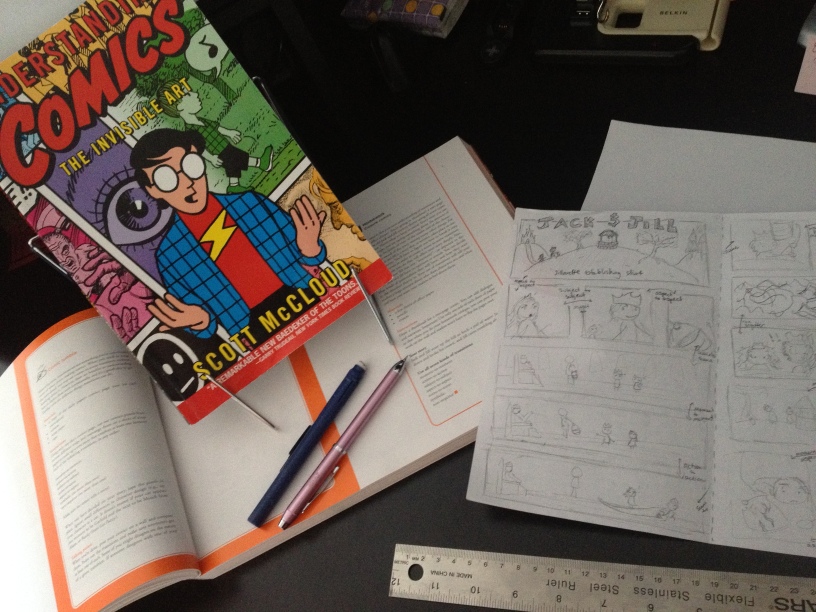This week’s lesson in Abel & Madden’s Drawing Words & Writing Pictures relied rather heavily on Scott McCloud’s Understanding Comics. The focus was simple: different transitions between panels that create different types of closure for the reader. Since readers have a tendency to story-make and connect panels into coherence, that gives writers/artists an advantage to be as specific or vague in our storytelling, to hone in on tiny details or get the speed of action across. McCloud offers six types of transitions, and Abel & Madden add a seventh. The transitions are (with my own paraphrased definitions):
- moment-to-moment – shows the incremental passage of time
- action-to-action – shows the beginning and end of an action, and lets the reader fill in the actual movement
- subject-to-subject – shows different characters/objects in the same scene
- scene-to-scene – shows different places/times
- aspect-to-aspect – shows different views of the same scene (like zooming in or noting setting details)
- symbolic – shows a non-literal representation of an emotion or situation
- non-sequiter – shows things that have nothing to do with one another, and as a result the reader really has to try to create meaning, which sometimes turns this type of transition into symbolic
To get a better understanding of the craft elements involved in all of these transitions, I sincerely suggest picking up McCloud’s text. Wolk has a great chapter on this in Reading Comics entitled “Pictures, Words, and the Space Between Them” if you’re interested in gutters and white space and the magic they create within a comic (from a literary perspective).
The “class” assignment involved cutting panels from a newspaper daily comic strip page and rearranging them to make a cohesive story using all different type of panel transitions. There’s a bunch of copyright laws and stuff involved, so even if I had done the project, I wouldn’t be able to show you what I did. (I didn’t have timely access to a newspaper, and if I had scoured the Internet that would have turned into distracted web-comic reading.) The activity is similar to the “extra-credit,” which involves making a card game out of random panels from Nancy comics. (Nancy seems to be held in high esteem by not only Abel & Madden, but McCloud as well. I didn’t grow up reading Nancy so there’s no real nostalgia factor for me there… I’d be much more enamored to read Calvin & Hobbs or Dilbert or something. But that’s just my personal preference.) The game sounds great, though, for quickly identifying transitions and evaluating their strengths and weaknesses. I wish I had known about it when I was in high school and had a strong artistic/writerly community that I spent a large amount of time with every day. (Not to say I’m not fond of the community I have in grad school, but our time together is largely limited to class and occasionally planned outings.)
The homework was challenging–and in a good way! I wish I had more time with it, so that I could have inked and colored it. Perhaps I can save that for another activity later. The prompt was to thumbnail draw a 2-page comic adaptation of the Jack & Jill rhyme using all seven transitions (as described above).

Jack and Jill went up the hill to fetch a pail or water. Jack fell down and broke his crown, and Jill came tumbling after.
To save paper/space and keep me from making the comic more complex than it needed to be, I just folded the paper in half to create two pages. I went ahead and labeled each transition to make sure I got them all. My non-sequiter panel isn’t really that non-sequiter. I tried, but obviously I had some intent behind where I put it and how it functions in the comic. All of the drawings are terrible, of course. It’s a thumbnail sketch. But hopefully you all can see and understand that Jack is a class-A Jackass. Toward the end you can see that my transitions were less “pure” and tended to blur together and function as several different types of transitions at once.
I lined up everything to start the re-pencilling on new paper, inking, and coloring, and then I realized I was out of time for the week! :(
Next week I’ll have more drawings for you! :]


